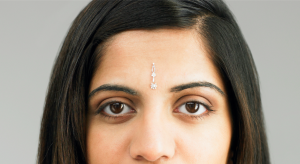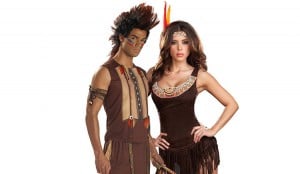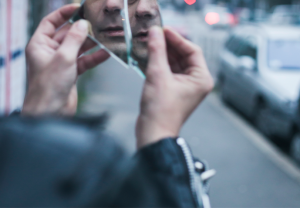Originally published on Wear Your Voice Magazine and republished here with their permission.
Countries across Asia and beyond are mired in a history of oppression. For many of us, the oppression is far from over, and we still exist within marginalized communities.
Over the years, the racial microaggressions that offend and upset us have mutated, but they are aggressions all the same. Look at it this way: When you have been colonized, had your finery stolen, and your identity poked fun at, cultural appropriation is not just personal; it points to a bigger picture.
The 2013 poster campaign “We’re a Culture, Not a Costume” by Ohio University highlighted how problematic it is to view someone else’s culture as make believe.
As an Indian woman, I don’t know where to start with the appropriation of Indian culture. I get it. We have opulence, grandeur, and a rich culture that evokes thoughts such as “mysticism” and “exoticism.”
When I wear the bindi, it makes me conservative and traditional, but if Vanessa Hudgens wears a bindi, it’s “cool?”
To add further insult to injury, ASOS decided that bindis were a Halloween accessory (thanks, ASOS, for putting the bindi in the same category as skeleton leggings). Thankfully the uproar from ASOS consumers made the company remove the selection on bindis.
Let’s go through a list ten of the most widely appropriated South Asian accessories and what they really mean.
1. The Bindi – Surprise, Surprise!

Image Credit: Author (Aarti Olivia)
The Bindi, also known as the Pottu (a red vermillion dot) or a tilak (a vertical marking), is placed on the center of the forehead between the eyebrows, which is known as the third eye, referring to the point of higher consciousness.
A black bindi is worn in parts of South India by unmarried girls, while married women wear a red bindi. Although not all Indian women follow these rules of color for bindis today, it holds a special significance. Men sport the tilak after a prayer or religious occasion. I have had the bindi placed upon my forehead since infancy.
The band No Doubt made waves on the radio and MTV when I was a teenager, and bindis became the new cool accessory thanks to Gwen Stefani. There is no doubt (no pun intended) in my mind that this pattern has probably been repeating itself for decades long before I was born since the West has always shown a keen interest in South Asian clothing and accessories.
While it looked cool to my friends when they sported a bindi, I could not help but feel strange about it, like an invasion of space.
My peers had no clue as to what the significance of the bindi was and given that I used to get strange stares when I did wear them before No Doubt’s popularity; I felt uneasy about the immediate mass appeal for it.
Little did I know, I would see history repeat itself over and over (and over) again until it came to a point where it got annoying to see yet another celebrity wearing bindi/s to music festivals.
When is it acceptable to wear a Bindi?
- If you are getting married to a South Asian
- If you attend an Indian festival/ritual and have a vermillion dot placed on you as a sign of welcoming one’s guest
2. The Maang Tikka

Image Credit: Pabak Sarkar via Creative Commons
The new favorite Indian accessory we have seen in plenty of in stores.
The center part of your hair is known as the Maang and is an important feature for married or soon-to-be married Indian women. The Tikka is the ornately jeweled part of the accessory that is placed onto the forehead.
It is styled differently, depending on what part of India you hail from – the Rajasthanis wear a Maang Tikka, otherwise known as the Bor, that has a simple round tikka at the forehead, while in a Muslim wedding, the Jhumar Tikka that is placed on the side of the head. There is a special significance for each variation. A bride-to-be typically wears an intricately embellished Maang Tikka.
When is it acceptable to wear a Maang Tikka?
- If you’re getting married to a South Asian
- If you are part of a South Asian bride/groom’s wedding entourage
3. The Nath (The Nose Ring)

Image Credit: Steve Evans via Creative Commons
Indians wore rings on the nostril and septum way before it got fashionable. Nose rings didn’t originate in India; they were brought to the region by the Middle East, thanks to the Mughal Emperors.
Like the Bindi and Maang Tikka, they have variations that hold special significance. Brides wear a nose ring that extend with a chain, and some rural parts of India wear larger nose rings as a sign of marital status or affluence. The women in my family have been wearing nose rings all their lives.
Which was why I was defiant in school when I was told to remove my nose ring after piercing my nose at fifteen. I did it to commemorate my very first trip to the homeland.
Naturally, I was sent to detention for disobedience, even though this is a mark of my culture. Today, when so many peers wear one, it’s not considered a problem.
I do not take issue with the nose ring as much, but I do not like the bridal nose ring being exported as yet another fun fashion accessory. This style of nose ring is specifically for the South Asian bride.
When is it acceptable to wear a Nath?
- When it is not a bridal nose ring being worn as a fashion accessory (the other styles are just fine)
- If it is a part of your own culture
4. The Paayal (Dancing Anklets)

Image Credit: Author (Aarti Olivia)
The foot is regarded in Hinduism as the humblest and most impure part of the body since it touches the ground first. Adorning a woman’s feet symbolizes an act of devotion by her family or spouse.
Gold anklets are strictly forbidden in Hinduism because Gold symbolizes Lakshmi, the Goddess of Wealth, and we do not place God at our feet.
Hindu babies are adorned with simple silver anklets and typically, a girl child continues to wear anklets while boys grow out of it. Anklets are also viewed as a symbol of femininity, coquettishness, eroticism, and dance.
When I learned the South Indian dance form known as Bharatanatyam, I wore thick anklets with bells known as the Saalangai, and when I picked up the Northern Indian dance form known as Kathak, I wore thicker anklets with bells known as the Ghungroo.
These hefty accessories are meant to accentuate the rhythm of dance and to appreciate the complex footwork for the forms of Indian dance.
Also, they are a very handy guide for dance teachers to figure out who is not dancing coherently to the rhythm. Not fun to get singled out in dance class, I can vouch for that!
During my time of study for both dances, it was not uncommon for a non-Indian to take interest in learning the dance forms. They practiced along with us and were respectful about it, while taking great care of the anklets (you are ordered to do so) and learned to tie it appropriately.
It is a different story, however, when a tourist thinks it’s fun to purchase these anklets and parade them with no knowledge of its use or history.
When is it acceptable to wear a Paayal?
- If your culture wears them as an accessory like us
- If you are an Indian dancer or a South Asian bride
5. Chudiyaan (Bangles)

Image Credit: Author (Aarti Olivia)
Indian women have been adorning their arms with bangles since ancient civilization.
Depending on region and community, bangles are made out of differing materials – glass, silver, conch, or shell. A newlywed bride from parts of North India and Punjab, for example, is expected to wear a full set of bangles known as the Chuda for the first two weeks of marriage.
While it has been traditionally expected that married women wear bangles, it is no longer imposed upon us. We do, however, wear them for religious or festive occasions. Like the paayal, infants are gifted with bangles.
In pop culture, you have probably seen the likes of Iggy Azalea and Selena Gomez wear them for music videos and performances.
When is it acceptable to wear Chudiyaan?
- If you are in attendance of a Hindu friend’s matrimonial functions and the dress code is Indian ethnic – but be sure to check with your host first
6. The Saree

Photo Credit: Khadija Dawn Carryl via Creative Commons
Like the bangle, the saree and textile weaving culture have been mentioned from the days of the Indus civilization.
It is still considered the primary piece of clothing in India even in modern wardrobes like mine and the tradition of draping one has been going strong for the past 6000 years. It is considered a symbol of Indian femininity and sensuality.
A saree is typically six yards long, and there are countless of textiles and draping methods that vary according to the region you hail from.
South Asian women across the world and from all walks of life wear them at home, during an occasion, while in attendance of prayer, or at the workplace.
It is worn with a blouse the length of a crop top and a petticoat used to help tuck in the pleats of the saree in order to hold it in place.
I am not the best at draping a saree, but I do appreciate the place it has in my life as an Indian woman. Since I am a North Indian married to a South Indian (our cultures could not be any more different), it has been interesting to see the differences in which we pick out fabrics and styles. It is a custom for the bride-to-be to be gifted sarees from her family, and I have an array of 25 sarees (I kid you not!) in my wardrobe.
The thing about wearing one is that the look is considered unfinished if you do not accessorize with at least bangles and a bindi. And even that is considered too simple!
When is it acceptable to wear a saree?
- If you are in attendance of an Indian function that stipulates Indian ethnic attire. It would be advisable to get a hand with how to wear one properly since it takes some effort.
- Please do not wear this for Halloween.
7. The Toe Ring

Image Credit: Flickr user indi.fetish via Creative Commons
Also known as the Bichiya or Metti, it is often seen on the feet of married women.
The tradition of wearing a toe ring has dated back to the Ramayana – a Hindu epic poem – where Sita tosses her toe ring after getting abducted by Ravana in the hopes that it would help her husband Lord Rama during his rescue mission.
The ring is typically made out of silver and worn in pairs on the second toe of both feet. There is an open hook at the back to make it easy for removal when it is in need of a polish or if the feet require a thorough cleansing.
Like the paayal, they are not made out of gold for the same reason. They are placed by the groom onto the bride’s feet during the Hindu wedding ceremony. I am unable to wear them due to nerve injuries on both feet, but I did have them on for the duration of my wedding ceremony.
When is it acceptable to wear a Bichiya toe ring?
- If you are married to a South Asian.
8. The Aum Symbol

Image Credit: Flickr user Tengriana via Creative Commons
Oh boy. Where do I begin with this one?
The most sacred symbol in Hinduism. The essence of all mantras and divine scripture.
It is the representation of the holy Hindu trinity of Gods – Brahma, Vishnu, and Shiva.
It is the representation of three worlds – Earth, the Atmosphere, and Heaven.
It is the representation of the three sacred Vedic scriptures – Rig, Yajur, and Sama. It is the sound of the conch at prayer.
This feels a lot more personal than the rest of the accessories mentioned. To even place it on this list feels wrong, but it has been “accessorized” and thus needs to be addressed.
The Aum is used everywhere now – and not as it should be.
We keep this symbol close to our being because it centers us and beckons us to perhaps utter a prayer (most Hindu prayers begin with the Aum). The reason this is uttered so often is because of the power it has to modify your pace of heart should you feel uneasy.
So when I see someone wearing it on their tie-dye camisole or sarong during a resort vacation, you can imagine how it feels. Just like in any other religion, we keep some things closer to our heart and spirit.
When is it acceptable to wear the Aum?
- If you sport one as a pendant, bangle, bracelet, or a tattoo (be mindful of its placement) and are a practicing Hindu
9. Hindu God Images as Tattoos

Photo Credit: Flickr user Nick Gray via Creative Commons
If you’ve read my article about the Australian who got into trouble for his Yellamma tattoo on his calf, you are then well aware that tattoos are not taboo for us, but the placement and imagery play an important part.
For a Hindu, a tattoo of the Aum, Sanskrit scriptures, or an image of a God/Goddess serves as a sign of devotion or has a protective quality.
Some of our Gods – namely Ganesh, Shiva, and Kali – seem to be cooler than the rest, and they have been tatted onto bodies across the world.
When is it acceptable to get a tattoo of a Hindu God?
- While I am deeply appreciative of tattoo culture, it would be advisable to get these tattoos only if they hold a deep significance to you
- Please mind where you place them on your body. The legs are considered the dirtiest part of one’s body, and getting one on your back is frowned upon.
10. The Mangalsutra, Also Known as Thaali/Maangalyam (South India)

Photo Credit: Flickr user Fatima via Creative Commons
This is a sacred thread of love and goodwill worn by married women as a symbol of their marriage.
It is one part out of the five signs of marital status of an Indian woman. The rest of the five have been mentioned in the article – toe rings, bangles, nose ring, and kumkum (vermillion powder worn at the Maan just before the forehead).
Historically, the tradition seems to have originated in the 5th-6th century A.D. Different regions and communities of India have varied versions of the mangalsutra or taali. Some wear it on a yellow thread, others on a thick gold chain, yet others have black beads strung together with two “vatis” representing the union of two strung at the end.
Some have diamond pendants while others have coral beads. The design really depends upon the family traditions. And, often the taali is elaborately crafted with representations of the family deity — Shiva, goddess Sri, the tulsi (basil plant), or the emblems of Vishnu.
The black beads of a Mangalsutra denote the safety of the groom’s life from evil forces. It is considered compulsory in some parts of India to wear the thread as a married woman due to its symbolism.
However, the appropriation of the Mangalsutra does not happen in Asia as much, but the pretty black beaded necklace has captured the eyes of many in the West.
11. Henna, Also Known as Mehendi

Photo Credit: Flickr user Josh Rodriguez via Creative Commons
While it is popularly known as decorative material, Henna paste was used in ancient civilization to provide comfort in diseases related to blood circulation and body aches, with a cooling de-stressing effect on nerves and muscles.
Some women still do make their own paste with the leaves, but it is most commonly used today by applying it with a plastic or paper cone to create more intricate patterns on hands and feet.
The earliest evidence of henna application appears to have been mentioned in Egypt and in the earliest Hindu Vedic ritual books. It is widely used in South Asian countries – India, Pakistan, Nepal, Bangladesh – as well as the Middle East and Africa.
Each of these regions apply henna with a unique significance to their culture. In India, Mehendi is typically applied during festivals such as Diwali and during weddings.
For women, these designs are drawn on the palm, back of the hand, and on feet, to contrast with the lighter skin on these surfaces, which naturally contain less of the pigment melanin. But times have changed, and we draw them on the front of our hands and legs to display the patterns henna artists work laboriously over.
Since there is a shortage of traditional mehendi artists, using plastic cones makes the application of henna easier and more accessible.
Henna “tattoos” have become just as commonplace as bindis within the Western culture.
The issue here is not the use of the plant; it is the convenient fashioning that inadvertently erases the cultural significance of this ritual that is a bother.
It seems to have fallen into the unfortunate pit that is “new age spiritual hipster living.” It is worn like a crown of “individual artistic expression” and uniqueness, when the fact of the matter is, the designs that we have been placing on our hands and feet are a symbolic representation to awakening the inner light, an ode to the sun.
Also, some of us don’t have a choice in the matter. When brides are married off without their consent (yes, it still happens), Mehendi is an unfortunate sign of patriarchy – submission to the unwanted matrimony, a possession of the feminine body.
So while this is a fun option for the West, it is an imposition on some in the East. There is so much history steeped in this and it is unfortunate that this thing of beauty has been commodified into a sticker set.
So if you are not a person of color, I would caution you against wearing this for an “Indianized” look – I don’t even know what that term is supposed to mean. It is offensive, but I have read it one too many times. Here’s looking at you, Madonna.
***
While you may have experienced the ire of a South Asian SJW for wearing our accessories, it is imperative to remember that we have always been welcoming and accepting of tourists or foreigners who wish to learn more about our way of life.
What tires us, however, is the misinterpretation, misrepresentation, and disregard of South Asian culture.
While there are more individuals who take it upon themselves to get educated about these details, there still exist the many who think it is exciting to dress up like us for the fun of it and water down or commercialize significant symbols. It is understandable that acculturation happens; a lot of us live in a merry existence of a myriad of cultures.
But be careful when threading the line between showing appreciation and respect for a foreign culture versus picking and choosing elements of it for a laugh.
While not everything done is inspired by a culture to appropriate off it, you might want to get some research done before you try something on to make sure you don’t come across as racially insensitive.
I do not wear these accessories often due to the nature of my work life and personal reasons surrounding “female obedience” – let’s just say I do not work well with authority!
But as you have read, I value and understand their significance enough to be able to inform you that these are not of mere aesthetic value. The rituals and symbolism of South Asian culture are beautiful. Just like how Dia de Los Muertos’ sugar skulls, catrinas, and ofrendas are part of a very important Mexican festival.
What you can do is support our art, culture, and music. And you can call out the appropriation of meaningful festivals or traditions when you see them happening, passing some of the knowledge you learned here along to them.
[do_widget id=’text-101′]
Aarti Olivia Dubey is a first generation Southasian Singaporean. She is a plus size fashion blogger, body positive advocate, and feminist. She holds a Masters in Psychotherapy with a focus on contemplative psychotherapy and psychoanalysis. Being a socially awkward introvert, she prefers to put her thoughts into writing while observing the world. She loves animals to a fault and is a happy fur-mommy to three dogs and two cats.
Search our 3000+ articles!
Read our articles about:
Our online racial justice training
Used by hundreds of universities, non-profits, and businesses.
Click to learn more





























